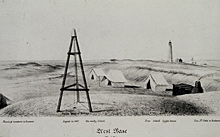Ferdinand Rudolph Hassler: Founder of the United States Coast Survey
- Introduction
- Hassler's Plan to Survey
- A Pioneering Scientist and Visionary
- Battling for Fairness
- A Man of Principle and Integrity

Ferdinand Rudolph Hassler served as the first superintendent of the United States Coast Survey. Click image for larger view.
Ferdinand Rudolph Hassler was born in 1770 in Aarau, Switzerland. As a young man, he displayed talents in both law and science and distinguished himself by taking part in the trigonometric survey of Switzerland and by serving as Attorney General during the French occupation in 1798. Holding strong beliefs in the principles of democracy, Hassler immigrated to the United States, arriving at Philadelphia in October 1805.
Hassler’s Plan to Survey the Coast
In December 1805, Hassler attended his first meeting of the American Philosophical Society. Historians believe that, as a result of professional contacts made through the Society, Congress passed a measure to conduct a survey of the coast on February 10, 1807. After passage of the act, Albert Gallatin, Secretary of the Treasury, issued a call for a plan for the Survey of the Coast later that year. Hassler’s plan was selected. He proposed to build a geodetic triangulation network as a framework for both topographic surveys of the shoreline and hydrographic surveys of harbors and offshore waters. Although technologies have changed, NOAA surveyors and hydrographers have followed Hassler’s basic plan for the past two hundred years.
A Pioneering Scientist and Visionary

Ferdinand Hassler directing movement of a 300 pound surveying instrument which he designed and proudly called the Great Theodolite. Click image for larger view.
Hassler accomplished much more than just surveying the coast. He invented the modern science agency and the oldest and most direct predecessor organization to NOAA’s Office of Coast Survey, National Geodetic Survey, Center for Operational Oceanographic Products and Services, and the Office of Marine and Aviation Operations. He was the pioneer who elevated the status of science in government and society; fought the first budget and administrative battles with bureaucrats and lawmakers who did not understand the nature of science or its requirements; trained a cadre of surveyors, topographers, and artisans who served the nation well beyond his death; and imbued the Coast Survey, and, by extension, the entire American science community, with unswerving devotion to accuracy, precision, and scientific integrity.
He came to a nation with little science infrastructure and left a thriving organization of mathematicians, geodesists, topographers, hydrographers, instrument-makers, engravers, and printers who worked in concert to collect and process the data for our nautical charts. He also helped establish our nation’s standards of weights and measures on a scientific basis, a function that resided in the Coast Survey until Congress founded the Bureau of Standards in 1901.
Battling for Fairness
In establishing the Coast Survey, Hassler experienced more than his share of vicissitudes. He defended himself and his views to Congress, comptrollers, and even presidents. He demanded, and received, what he considered just pay for his work and services to the nation which gained not only respect for himself but for all scientists who followed in his footsteps. He was the pioneer in defending Coast Survey personnel against the spoils system and made the Coast Survey the first federal agency to adopt a merit system for hiring and promotion.
A Man of Principle and Integrity

Ferdinand Hassler's surveying camp at the west end of Fire Island on the south shore of Long Island in the 1830s. Click image for larger view.
Hassler was attacked not only for his scientific methods, but also for being a foreigner, speaking with an accent, and even for his manner of dressing. He responded by displaying a sophisticated understanding for using the press and published articles in rebuttal. He championed his views through the Transactions of the American Philosophical Society and even published The Principal Documents of the Coast Survey out of his own funds to distribute to members of Congress. Through it all he prevailed because of unswerving devotion to attaining scientific truth and unwillingness to compromise his values.
Hassler died in 1843, a few days after finishing field survey work for the year and writing his final report. This first professional American scientist left a legacy of accuracy, precision, and scientific integrity with which he imbued not only the Coast Survey but, ultimately, all American science institutions. Officers of the Army and Navy who had served with him erected a monument at his gravesite with the following inscription:
IN MEMORY OF
FERDINAND RUDOLPH HASSLER
BORN AT AARAU IN THE CANTON OF ARGOVIE, SWITZERLAND
OCTOBER 6, 1770.
HAVING FILLED WITH HONOR BOTH IN HIS NATIVE AND ADOPTED COUNTRY
OFFICES OF HIGH TRUST AND RESPONSIBILITY
DIED IN PHILADELPHIA
NOV. 20, 1843
IN THE MIDST OF HIS LABORS AS SUPERINTENDENT OF
THE UNITED STATES COAST SURVEY
AND
STANDARDS OF WEIGHTS AND MEASURES
BOTH GREAT NATIONAL WORKS FROM THEIR ORIGIN ENTRUSTED TO
AND CONDUCTED BY HIM WITH DISTINGUISHED REPUTATION AND SUCCESS.
STRICT INTEGRITY AND LOVE OF TRUTH, WITH STRENGTH
AND ACTIVITY OF INTELLECT, CHARACTERIZED HIM AS A MAN,
WHILST HIS VARIOUS SCIENTIFIC WRITINGS AS WELL AS
THE TWO NATIONAL WORKS PROJECTED BY HIM ARE ALIKE
MEMORIAL OF HIS LABORIOUS LIFE AND OF HIS CONTRIBUTION
AS A MAN OF SCIENCE TO THE INSTRUCTION AND IMPROVEMENT
OF HIS FELLOW MEN.









